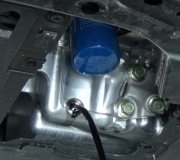This argument is moot. Hot oil does "thin out" but that doesn't change its volume or level. Watch the next time she makes Jello. It doesn't shrink or run over the bowl when it sets up to its "nervous" state. Cold oil does indeed have time to run down from on top of the engine but now we're talking about a few tablespoons of oil on top of an area about 8" x 12". You aren't going to see a noticeable change. When you pull into a service station and want to check your own oil, by the time you climb out of the car and open the hood, the oil will have run down already. If it hasn't, you have a much more serious problem of sludge blocking the drain back holes in the cylinder head.
To say it a different way, if you check the oil level and it's okay, it's going to still be okay regardless if you check it next time hot or cold, one minute after stopping the engine, or an hour later.
To add another dimension to my exciting story, all engines today use some oil between oil changes. To address the customer complaints of years ago, almost all manufacturers now label their dip sticks with "Min" and "Max" instead of "Add" and "Full". When they had "Full" marks, people got upset if the level dropped even a tiny fraction of an inch. With the new markings, as long as the level is above the "Min" mark, you don't need to add any oil.
The easiest way to prove to yourselves there's no difference, check the level right after stopping a hot engine, then again after it has cooled down. When it's hot, be sure to wipe the dip stick off first because oil will have splashed up higher on it. That can be taken as an incorrect reading.
Monday, August 11th, 2014 AT 9:00 PM




